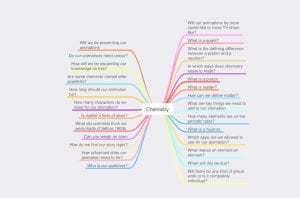Hello and welcome back to another amazing blog post by yours truly!
As always here’s the driving question:
How do the Electron Arrangements of Atoms Determine the Chemical and Physical Properties of Elements and Compounds?
In this project, our main goal was to create an animation, with two separate stories, explaining ionic bonds and covalent bonds. If you continue reading, then I’ll explain the process behind this project!
first off, as always we started with a mind map, expressing what we already knew, and our questions:
Once we had our mindmap put together, it was time to start building our understanding about chemistry. Throughout most of this project, we were reading textbooks and completing workbooks to help our knowledge grow about the information we will be using in our animations. I found these rather helpful.
In the textbooks, we learned about pure substances and mixtures, elements, the periodic table, non-metals, semi-metals, and metals, parts of the atom, ionic compounds, covalent compounds, and diatomic molecules, as well as binary ionic and covalent bonds, multivalent metals, polyatomic ions, and, of course, writing chemical formulas for chemical bonds!
Then we did an in class experiment to get us interested! It involved test tubes, mossy zinc and fire!
Then we began working on our animations. At first, all we did was choosing atoms, compounds and a basic story. Then, we got to work mapping everything out, and creating story boards for our eventual animations. With that in mind, our main goal was to accurately explain ionic and covalent bonds through a story with characters.
Then winter break plus an extended week went by, aaaaaand then we got back on track
Pretty much from then till now, we worked on our animations and the occasional work book.
Curricular competencies:
Communicating: Formulate physical or mental theoretical models to describe a phenomenon.
I believe I did a successful job at this competency, explaining the process of ionic bonding and covalent bonding through animation with accurate depictions.
Processing and Analyzing: Construct, analyze and interpret models and/or diagrams
I think i did an accomplished job here, using correct Bohr diagrams for all of my chemistry characters.
Questioning and Predicting: Demonstrate a sustained intellectual curiosity about a scientific topic or problem of personal interest
I think I showed good curiosity throughout this project, it was actually pretty interesting and I like the periodic table so, I’d say it was a topic of interest for me.
Oh and here is my video
alrighty, hope you enjoyed!
